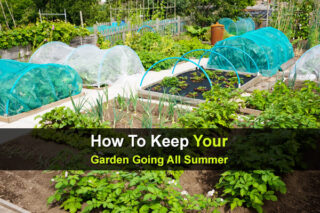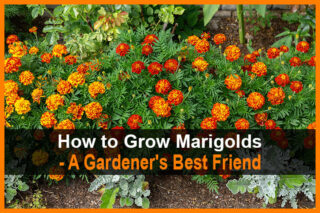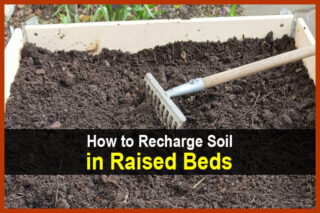Estimated reading time: 6 minutes
Raised bed gardening in a highly versatile form of growing crops in both small and large places. Because such a wide variety of vegetables can be grown in a raised bed, they are popular with homesteaders in rural, suburban, and even urban environments. This manner of gardening got its name because the soil that the plants are grown in is raised above ground level and is often enriched with compost.
While traditional raised bed gardens are constructed of wood boards, they can also be made out of rock, concrete, cinder blocks, bricks, corrugated metal, or even straw bales. A raised garden bed can basically be made out of just about any sturdy material that can hold dirt. A typical raised garden bed is constructed in a square shape that is three to four feet wide.
The raised garden bed can be designed to be as narrow or as wide as the gardener wants or needs to meet the confines of the available growing space. Typically, a raised bed is no wider than four feet across to allow for ease of access from only one side when the gardener is harvesting, staking, pruning, or weeding the plants growing in the constructed plot.
Want to save this post for later? Click Here to Pin It On Pinterest!
Do Raised Beds Need A Bottom?
There is no need to put a bottom on a raised bed to make the growing structure sturdy, but adding a layer of hardware cloth (rabbit pen wire mesh) will help prevent burrowing pests like gophers and groundhogs from stealing your crops.
A tabletop-style raised bed will need support boards across the bottom of the frame and hardware cloth firmly attached to keep the dirt from falling out because it is elevated completely off the ground. Patio or deck raised beds, which are also becoming far more commonplace, could benefit from a bottom board with ample drainage holes as well.
What Shape Are Raised Beds?
A raised gardening bed is traditionally created in either a square or rectangular shape. Raised beds can be created in any shape that is needed to fill space in the backyard or even in the front yard as part of an edible landscaping project.
How Tall Are Raised Beds?
A raised garden bed can be as deep as needed to accommodate the plants that will be grown in it. Some beds are just a few inches above the ground and others are several feet deep. One of the latest additions to this popular gardening trend is for tabletop-style raised beds, like the one below.
Building raised beds at this height allows gardeners to both weed and pick the plant without constantly bending over and back up. The most dreaded part of growing your own groceries is tending to the weeds that grow around the plant as it matures.
A tabletop raised bed increases growing opportunities for older folks, people with disabilities, and just gardeners who are generally sick and tired of having an aching back all summer long.
What Can Be Grown In A Raised Bed Garden?
Anything that can be cultivated in a traditional ground plot can be grown in a raised bed garden – even corn. The size and depth of the raised garden beds you build to suit the space available will dictate what type of plants and how many of them can be grown in each raised bed.
Shallow raised beds that are used as edible landscaping on decks, patios, and in place of traditional flower beds are ideal for cultivating lettuce, onions, carrots, radishes, and herbs. Raised beds that are constructed more deeply can house tomato, green beans, peppers, soybean, corn, potatoes, broccoli, and cabbage.
Growing vine crops such as pumpkins, squash, and cucumbers can be accomplished in a raised bed garden. When planning to grow crops that spread out like the ones noted above, the raised bed should be a full four feet across – and some vines may still dangle out and curl over on the ground.
Top 7 Reasons Raised Bed Gardening Is So Popular
1. Flooding and Drainage
Gardening in the ground in areas that have poor drainage or are prone to flooding can kill a crop rapidly. Cultivating plants above ground level helps to prevent the naturally occurring wet conditions from negatively impacting fruit and vegetable plants.
2. Enhanced Growing Season
The soil in raised beds not only drains more quickly but also warms up faster during the early months of the year – and retains heat into the early weeks of fall.
Placing a snug-fitting glass pane in sections over top of the raised bed garden plots permits them to be used as a cold frame or mini greenhouse environment for seed sowing and young plants.
3. No Tilling Required
For folks who favor a no-till garden for environmental reasons, raised beds are a superb way of growing crops without disturbing the ground. If you only have a small space to grow groceries and/or do not have a tractor or push tiller, a raised bed makes setting up a growing operation both simple and inexpensive.
4. Predator Protection
Raised beds are far simpler to fence in or cover with growing hoops due to their small size and firm frames. Attaching bird netting above a raised bed garden involves the use of only a small amount of inexpensive netting and some thin stakes.
Deer fencing or hardware cloth can be affixed around wood slats or stakes to keep larger destructive animals like deer and rabbits away from your crop without spending a fortune or taking up a weekend or more of your time.
5. Weed Control
Because the soil is not tilled, weeds seeds are not sifted about and perhaps even encouraged to grow. Layering straw onto the raised garden bed to prevent the growth of weeds quickly, easily, and inexpensively helps to keep them at bay and reduces your gardening chore “to do” list.
6. Soil Quality
Setting up a raised bed garden does not require quality ground soil. You can purchase soil in large bags to fill the frame and immediately start a garden.
Generating top-quality ground soil can be a time consuming and sometimes obstacle-filled endeavor. Losing an entire crop or experiencing only a low yield is a waste of both time and money – and unfortunately turns a lot of folks off of gardening forever.
7. Temporary Growing Plot
If you are renting a home or planning a move in the near future, setting up a traditional ground growing pilot may not be allowed or could be a lot of work for just a single season of growing. Raised garden beds are easy to install and can be taken apart to move with you and set up again in a new spot.
How to Build a Raised Garden Bed
It's easier than you think. In the video below, Hollis shows you how he built a simple raised bed with only $30 worth of materials.
Like this post? Don't Forget to Pin It On Pinterest!











